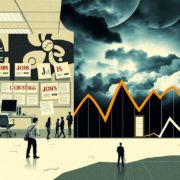Economic Outlook Dims: U.S. Employment Growth Slows as Manufacturing Faces Setbacks
Employment Growth Slows as Regional Manufacturing Returns to Contraction, Signaling Economic Cooling
November 20, 2025 — New data on jobs and factories from the United States show a slowdown in economic strength. Employment growth slows while regional manufacturing slips into contraction. Market experts watch these signs as hints of more easing soon.
U.S. Payroll Growth Moderates
Data from November 20 by the Bureau of Labor Statistics shows that nonfarm payrolls grew by 119,000 jobs in September. The rate is lower than before, and the unemployment rate stays at 4.4%.
Hourly pay rose 0.2% to $36.67. Annual wage growth holds at 3.8%. Weekly work hours stayed at 34.2. A government shutdown delay changed the release time, yet most survey work ended before the delay.
The household survey counted 7.6 million unemployed people. Long-term unemployment held at 1.8 million, which is 23.6% of the jobless group. Labor force participation moved up to 62.4% while the employment-to-population ratio stayed at 59.7%.
Job gains came mainly in healthcare (+43,000), food services (+37,000), and social assistance (+14,000). Jobs in transportation and warehousing dropped by 25,000. Storage lost 11,000 jobs and courier services lost 7,000. Federal government jobs fell by 3,000, which makes the year-to-date drop 97,000. Regional Manufacturing Activity Contracts Again
The Philadelphia Federal Reserve’s November Manufacturing Business Outlook Survey shows a weak region of manufacturing.
The overall activity index, which is now -1.7, stayed below zero though it improved from past months. New orders (-8.6) and shipments (-8.7) also fell. This move into negative marks lower demand. The index for employment climbed to 6.0. Sixteen percent of firms report more hiring, but the average workweek dropped to 3.7. Price pressures persist but with less force. The prices paid index grew to 56.1 while prices received sank to 17.7. Firms also cut down their expected selling price for the next year to 3.0% from 4.1%. The six-month outlook index climbed to 49.6, its highest mark in a year.
Market Implications: A Bearish Near-Term Outlook
Soft payroll growth and selected job gains come with lower manufacturing orders and shipments. Wage growth stays steady. Business views of rising prices now soften.
Analysts see these numbers as signs that the economic push is weakening. These signs may cause market players to get ready for a softer economy or changes in monetary policy.
In sum, the latest reports on jobs and manufacturing show a careful U.S. economic scene. Limited job gains and lower industrial demand make near-term growth less strong.
—
About the Author:
James Hyerczyk is a seasoned U.S.-based technical analyst and educator with over 40 years of experience in market analysis and trading. He focuses on chart patterns and price movement, has written two books on technical analysis, and holds strong knowledge in both futures and stock markets.
Full money-growing playbook here:
youtube.com/@the_money_grower








